Menus
- What’s up on a high-speed course?
- How violently this surface-to-surface missile accelerates?
- From zero to 100 in three seconds
- Kawasaki Ninja H2R with 310 PS?
- Pure madness!
- GPS relativizes the speedometer display
- What do the measured values look like on the test bench at home??
- Technical details Kawasaki Ninja H2 / H2R
- Acceleration comparison
- Performance measurements
- Offers and price comparison for used Kawasaki Ninja H2
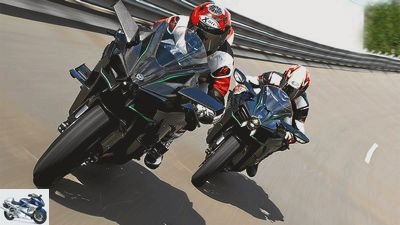
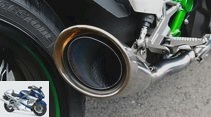
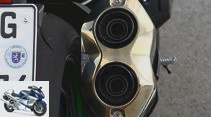
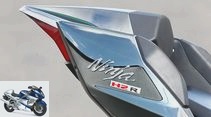
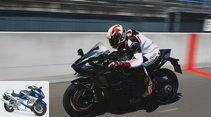
28 photos
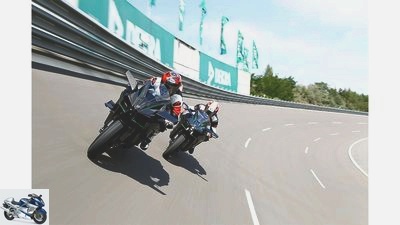
1/28
They cause a stir – not least thanks to the built-in compressor.
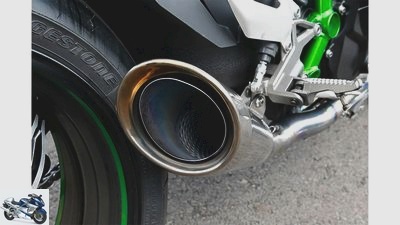
2/28
“Silencer” is not exactly the right expression for the pipe into which the four elbows open. This makes the Kawasaki Ninja H2R look more delicate than …
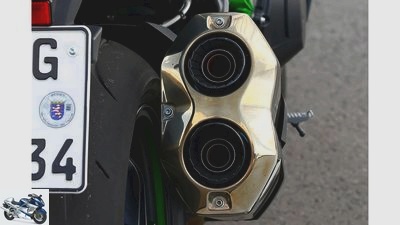
3/28
… the Kawasaki Ninja H2 with its large exhaust bag.
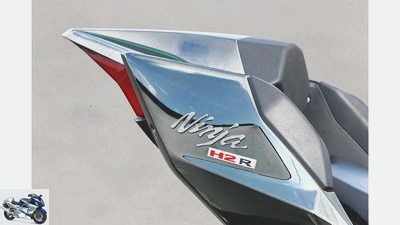
4/28
Kawasaki Ninja H2R.
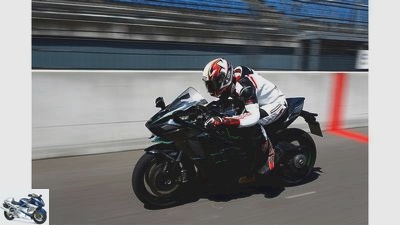
5/28
Kawasaki Ninja H2.
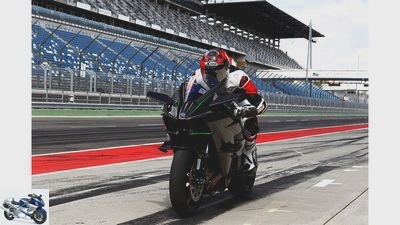
6/28
Even if the black lines in the picture were brought together by many motorcycles – the Kawasaki Ninja H2R would have no problem leaving such asphalt drawings at any time on command.
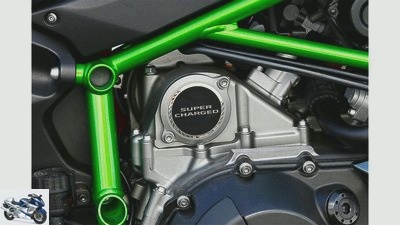
7/28
Particularly excellent: the compressor.
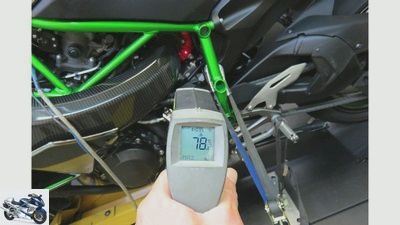
8/28
The test bench of the Hockenheimer tuner Herbert O. Kainzinger brought the declared performance to light at least to some extent. The compressor keeps an astonishingly cool head during the test bench runs.
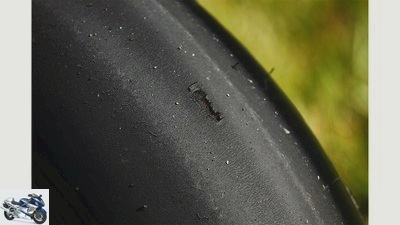
9/28
Even the best slick cannot withstand the concentrated stress of compression in the steep wall curve and subsequent speeds of over 300 km / h.
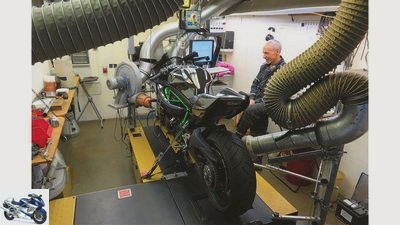
10/28
Unfortunately, the test bench could not supply enough air, so that the Kawasaki Ninja H2R lagged behind the declared performance.
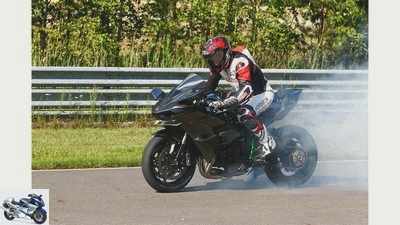
11/28
In the wild, it makes better use of its potential.
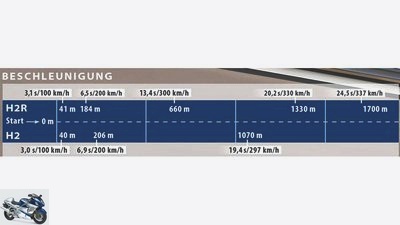
12/28
Only when sprinting to 100 km / h does the tamer Kawasaki Ninja H2 have the edge – by a tenth or a meter. Then the H2R takes off. If the H2 needs a good kilometer to get up to speed, the Kawasaki Ninja H2R breaks the 300 wall just two thirds of the way.
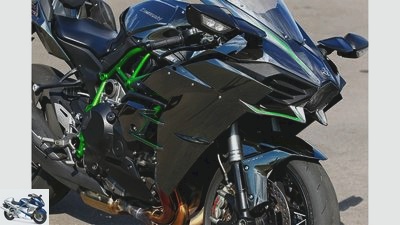
13/28
So the Kawasaki Ninja H2 can really inspire you.
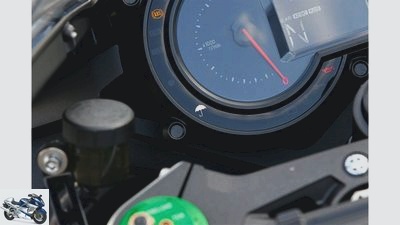
14/28
No, the umbrella does not indicate a weather app. It signals that rain mapping is activated. A feature that the Kawasaki Ninja H2R lacks – of course.
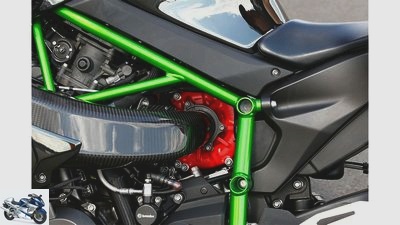
15/28
The compressor rotates at 9.2 times the crankshaft speed, in an emergency with 130,000 revolutions, and slurps 200 liters of air per second.
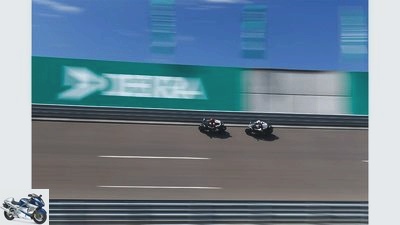
16/28
But how do Kawasaki’s ninja H2 and H2R fare when they compete against each other? We took them with us on the high-speed course.
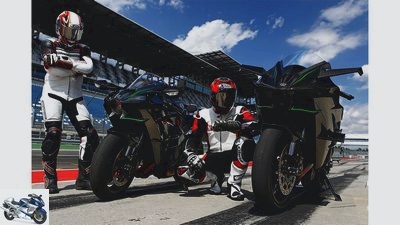
17/28
The street-legal Kawasaki Ninja H2 (left) has a good 100 hp less than the mighty Kawasaki Ninja H2R (right).
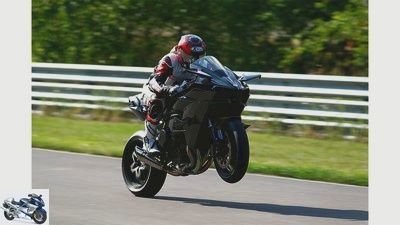
18/28
Kawasaki specifies 310 hp for the H2R – at 14,000 rpm.

19/28
The Kawasaki Ninja H2, on the other hand, reaches its maximum performance at 11,000 rpm: here it is 200 hp.
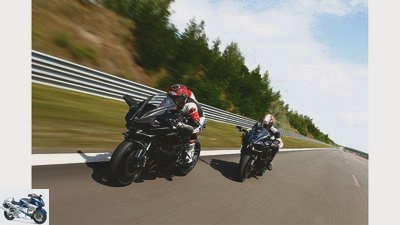
20/28
In order to implement the performance at top speed, special conditions are required: An eternally long straight (2.3 km!), …
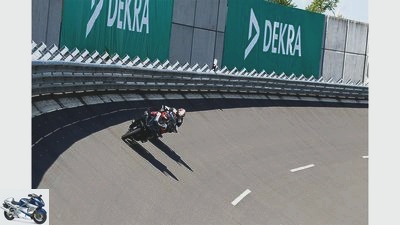
21/28
… then a 43 degree steep curve before it goes on the 2.3 km long back straight and over the second steep curve back to the starting point.
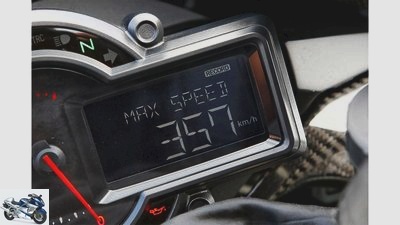
22/28
Of course, you can accelerate properly and, above all, safely, and so we reached a top speed of 357 km / h. The incorruptible GPS puts this into perspective to an impressive 337 km / h.
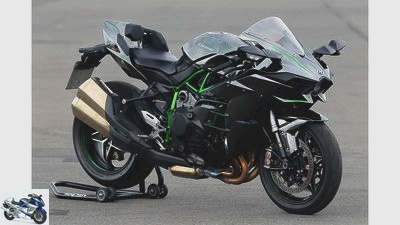
23/28
Kawasaki Ninja H2: water-cooled four-cylinder four-stroke engine, four valves, bore x stroke 76.0 x 55.0 mm, 998 cm³, 147.2 kW (200 hp) at 11,000 / min, 133 Nm at 10,500 / min, injection system, six-speed gearbox , Chain drive; Bridge frame made of aluminum, upside-down fork, Ø 43 mm, tires from / h .: 120/70 ZR 17 and 190/55 ZR 17, front disc brake, Ø 330 mm, rear disc brake, Ø 250 mm, wheelbase 1455 mm , Steering head angle 65.5 degrees, caster 103 mm, weight 239 kg, price 25,000 euros.
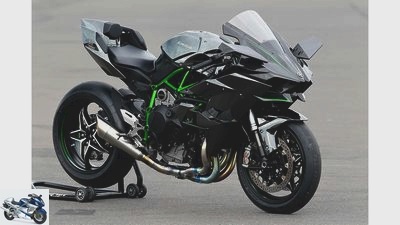
24/28
Kawasaki Ninja H2R: water-cooled four-cylinder four-stroke engine, four valves, bore x stroke 76.0 x 55.0 mm, 998 cm³, 228.0 kW (310 hp) at 14,000 / min, 165 Nm at 12,500 / min, injection system, six-speed gearbox , Chain drive; Bridge frame made of aluminum, upside-down fork, Ø 43 mm, tires from / h: 120/600 R 17 and 190/650 R 17, front disc brake, Ø 330 mm, rear disc brake, Ø 250 mm, wheelbase 1455 mm , Steering head angle 64.9 degrees, caster 108 mm, weight 218 kg, price 50,000 euros.
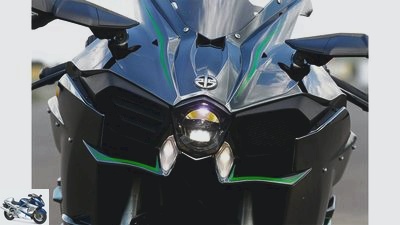
25/28
The Kawasaki Ninja H2 only draws its fresh air through one of the two nostrils. The tiny headlight is a concession to the approval regulations.
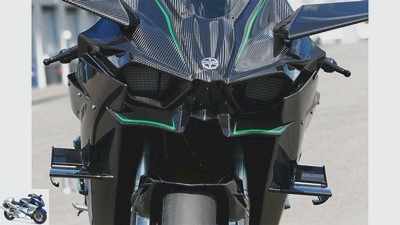
26/28
The Kawasaki Ninja H2R has both intake openings free so that it gets enough air; the filter element is located directly behind it.
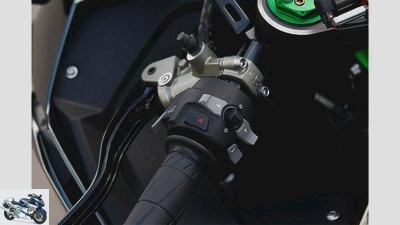
27/28
On the Kawasaki Ninja H2, all buttons have a function. The H2R dispenses with a horn and hazard warning lights.
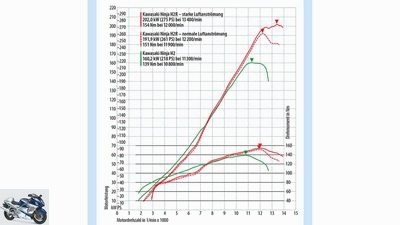
28/28
Thanks to the compressor, both bikes almost show a straight line in the performance diagram – and thus come close to the optimum.
Acceleration test Kawasaki Ninja H2 and Kawasaki Ninja H2R
What’s up on a high-speed course?
They caused a stir, the Kawasaki Ninja H2 and Kawasaki Ninja H2R. With a polarizing appearance, forced ventilation by a compressor – the pressure of expectation is high. What’s up on a high-speed course?
"Well now they’re completely crazy." This or similar thoughts are likely to have crossed their heads when they saw Kawasaki’s supercharger monster Kawasak Ninja H2R and the power rating of 310 hp for the first time face to face. And in addition to a good deal of amazement, in most cases a good shot of respect should have swung along. Before the technical achievement, the technically clean design, but above all before the boldness to dare to do something like this at all. But even more urgent than the question of why was the question of how. Namely: How can such a part of hell work when it is completely unleashed?
Buy complete article
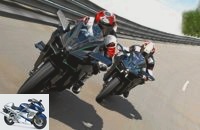
Acceleration test Kawasaki Ninja H2 and Kawasaki Ninja H2R
What’s up on a high-speed course?
To lure the Kawasaki Ninja H2R out of top speed reserve.
How violently this surface-to-surface missile accelerates?
Forget handling, suspension or braking. Here and now it’s all about one thing: speed. How violently does this surface-to-surface missile accelerate, how much does it pull through? And: how fast does it really go? Also in tow: the street sister Kawasaki Ninja H2, trimmed to 200 hp. How far can she keep up? Does she even have a chance? The next few minutes will tell. The Kawasaki Ninja H2R lurks on assembly stands while the electric blankets make their slicks steam. Meanwhile, top tester Karsten Schwers slips into racing leather and carefully stows the recording in his hip pocket. When the adrenaline has subsided after the orgy of speed and acceleration, incorruptible readings should prove every tenth of a second.
The Kawasaki Ninja H2 makes the start. Strong 218 hp with a fat plateau from 11,000 rpm and an exemplary performance curve, as if drawn with a ruler. Karsten grins slightly to himself, the route safety gives the green light, the show can begin. Karsten will accelerate the H2 several times, up to top speed. To do this, measure the draft. Not only in the usual dimensions up to 150 km / h, but also what happens from 150 to 250 km / h.

Super athlete
Kawasaki Ninja H2 in the top test
218 hp put to the test
read more
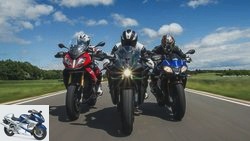
Naked bike
Aprilia Tuono V4 1100 RR, Kawasaki Ninja H2 and BMW S 1000 XR in the comparison test
A colorful trio
read more
All tests and articles about the Kawasaki Ninja H2
From zero to 100 in three seconds
Karsten goes on the trip. From a distance, the howling of the four-cylinder can be heard at a standing start, three or four times until the measurements are correct. And then there are the first goosebumps of the day. Karsten comes in with the Kawasaki Ninja H2 on the hunt for top speed. But you don’t hear an engine roar. Instead, all of a sudden, a rushing sound rises, as if a mighty storm was approaching within seconds and driving through the treetops. Then Karsten flies by, as flat as a flounder on the tank, and you can almost only hear this huge hissing sound, which even swallows the noise of the engine.
Karsten comes back and the slight grin has turned into a big one. “There, try it for yourself,” he pushes the key into my hand. How numbers can be deceiving. Although nominally “only” 200 hp, the Kawasaki Ninja H2 pulls out its arms when accelerating like no other 200 hp bike. Up to 100, 150 km / h still halfway comparable with the current 1000-series, the H2 goes off like being fired from a catapult. From zero to 100 in three seconds. The 200 mark falls after 6.9 seconds. The H2 206 meters are sufficient for this. In doing so, she already distances a BMW S 1000 RR.
Only by 0.3 seconds, but while ordinary 1000s in the 200 hp league more or less laboriously accelerate towards their top speed, the raging on the H2 continues undiminished. 200, 250, 270 – the thrust just doesn’t stop. After 19.4 seconds or 1070 meters, the limiter stops the Kawasaki Ninja H2 from moving forward at 297 km / h. Although 34 kilos heavier than an S 1000 RR, despite the unfortunate gear spread for this purpose, which forces a gear change shortly before the 200 mark, and aerodynamics that are probably more optimized for stability than Vmax. On the other hand, when sprinting to 100 km / h, the high front wheel load prevents excessive wheelies. So, pause, take a deep breath, the real monster is still waiting.
Kawasaki Ninja H2R with 310 PS?
Kawasaki Ninja H2R. Kawasaki promises 310 hp, speaks of 326 “with Ram Air”. Although it also works with 2.4 bar boost pressure like the H2, it is not regulated back as early as with the road offshoot. In addition, sharper camshafts, higher compression and an adapted mapping that makes the H2R cheer up to 14,000 rpm are the ingredients of the performance cure. Instead of breathing through one, the H2R breathes through both intake nostrils in the fairing nose, which also have an air filter that has four times the area and only a fourteenth of the flow resistance of the H2 filter. Plus a four-in-nothing titanium exhaust system for free breathing. The exhaust port: a yawning hole, a clear view of the collector.
The Kawasaki Ninja H2R wakes up with a hell of a scream, babbling irritably. The short exhaust stub doesn’t even bother to act as a silencer. Almost 100 dB (A) while idling, cheers! Is Karsten still grinning behind his tinted visor? With a brutal noise flag in tow, he dashes onto the track. The roar of the four-cylinder can be heard from afar as it tries to accelerate. And then the H2R breaks down the long straight like a jet fighter, turning with an infernal howl at the 14,000 mark.
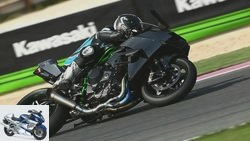
Super athlete
Kawasaki Ninja H2R in the PS driving report
Pure madness
read more
All tests and articles about the Kawasaki H2R
Pure madness!
Karsten rolls out, hands me the key of the Kawasaki Ninja H2R, “Crazy!”, His only comment. He is right. The brutal force of the four-cylinder engine is speechless. With almost 200 km / h at the top of the steep curve close to the guardrail, every steering movement needs to be carefully considered, the guardrails reflect the angry roar of the four-cylinder, then full shower on the straight. As if in time lapse, it winds through the lane under the pilot. Even in the upper gears, the needle on the rev counter snaps towards the limiter, as is known from conventional superbikes at best in second or third gear. The four-cylinder bites, rages and roars its soul out of the body that there is hardly any time to think. Left and right no longer exist, only in front.
The eye clings to the steep curve that is approaching. But long before the end of the straight is reached, the forward drive fades. At 357 km / h on the display, the limiter stops the raging. While the Kawasaki Ninja H2 shows minimal tendency to stir at top speed over time, the Kawasaki Ninja H2R runs straight ahead like a freight train, as stable as a pin. Kawasaki’s aerodynamics division has apparently done a great job. The carbon wings – unit price around 2000 euros – do not miss their effect. A lot more would be possible with a longer translation. After a good 70 kilometers measurement drive, the reserve light of the 17-liter tank lights up. Assuming a reserve of three to four liters, the H2R would have sucked in an average of around 22 liters per 100 kilometers – which corresponds to the display on the on-board computer. Internal cooling seems to be essential with this engine.
GPS relativizes the speedometer display
Back in the paddock, noise measurement is the order of the day. Kawasaki speaks of 120 dB (A). When measuring stationary noise, the noise exceeds the measuring range of our sound pressure meter. It ends at 130 dB (A) – the pain threshold. Karsten has now read out the recording. The readings leave even savvy testers speechless. From zero to 100 it loses a tenth to the Kawasaki Ninja H2 in 3.1 seconds. The more biting performance and the more violent wheelie tendency are just not that easy to control. But then the hammer falls. After 6.5 seconds, the Kawasaki Ninja H2R breaks the 200 barrier. It only needs 184 meters for this. After just 660 meters or 13.4 seconds, the monster cracks the 300 mark. Indeed: madness.
The incorruptible GPS puts the speedometer display into perspective to a still impressive 337 km / h. 93 meters per second! The Kawasaki Ninja H2 can’t keep up with that. However, it does not lose out completely. In the draft she turns the R a long nose. From 50 to 150 it takes 8.1 to 10.8 seconds over two and a half seconds. And from 150 to 250 km / h it is still 0.3 seconds with 7.7 compared to 8.0. That would restore her honor. However, there are no further measurements with the Kawasaki Ninja H2R. The rear Bridgestone slick has surrendered under the brutal stress of steep turns and high speed, pieces are starting to detach from the tread. So pack up and go home. The last test is still to come, the performance measurement.
What do the measured values look like on the test bench at home??
But on the domestic test bench there is disillusionment. Just 261 hp, but above all a curve that drops from 12,200 rpm. There has to be something wrong. Presumably the blower does not manage to deliver the necessary air speeds and above all the 200 liters of air per second that the compressor sucks into its throat in its greed at maximum speed. What the sensors and electronics of the Kawasaki Ninja H2R regulate the performance back.
Herbert O. Kainzinger, tuner and specialist for viciously powerful engines and who owns a test bench with a hurricane blower, should be able to remedy this. There we produce at least 275 hp and a more respectable power curve. But if too much air is probably still flowing past the intake openings, the pressure conditions for the sensors in the airbox are still not right. Presumably this would have to be determined in a test drive and then seal the blower on the intake nostrils and generate precisely the required pressure conditions. But unfortunately that is beyond the time frame, the H2R is eagerly awaited at Kawasaki. But the trend is clear: 300 hp shouldn’t be a utopia. And maybe an exhaust manufacturer will take pity on it: A slightly more subdued system with a subtle look without great loss of performance should be feasible. Then the Kawasaki Ninja H2R would be an absolute screamer on the racetrack.
Technical details Kawasaki Ninja H2 / H2R
The street-legal Kawasaki Ninja H2 (left) has a good 100 hp less than the mighty Kawasaki Ninja H2R (right).
Acceleration comparison
Acceleration comparison between Kawasaki Ninja H2 and Kawasaki Ninja H2R.
Only when sprinting to 100 km / h does the tamer Kawasaki Ninja H2 have the edge – by a tenth or a meter. Then the Kawasaki Ninja H2R takes off. If the H2 needs a good kilometer to get up to speed, the H2R breaks the 300 wall after two thirds of this way.
Performance measurements
Performance chart.
Up to 7000 rpm, the Kawa four-cylinder generates significantly more torque in the H2 configuration with tamer control times. In conjunction with the slightly shorter overall gear ratio, this ensures better pulling power – despite the higher weight. In addition, the performance curve is almost ideally straight. Only from 7000 rpm does the unleashed drive of the Kawasaki Ninja H2R come with all its force. The dashed curve shows the measurement result with a normal flow of fresh air onto the cladding front.
From 12,200 rpm, however, the electronics apparently intervenes due to irregular pressure conditions. Blown at a wind speed of around 320 km / h, the intake conditions apparently suit the electronics much better. In order to create the exactly necessary conditions, a more extensive test setup would have been necessary. What was striking was how snappy, how effortlessly the engine revs up on the test bench even in sixth gear.
Offers and price comparison for used Kawasaki Ninja H2
1000PS marketplace app
Prices are high, but availability is good.
The Kawasaki Ninja H2 is one of the most extreme motorcycles on the market, which is also evident from the price in the used market. The availability is still comparatively good and you shouldn’t have any problem finding a Kawasaki H2 nearby. Here is a price overview for used Kawasaki Ninja H2: used Kawasaki Ninja H2 in Germany.
Related articles
-
Deadline 2017 for the Kawasaki Ninja H2, Kawasaki Ninja H2 Carbon and Kawasaki Ninja H2R
factstudio.de 28 photos fact 1/28 They cause a stir – not least thanks to the built-in compressor. fact 2/28 “Silencer” is not exactly the right…
-
Gargolov Top-Test Kawasaki ZZ-R 1200 Wuchtbrumme A sports tourer, mighty, strong, carved from the solid: the Kawasaki ZZ-R 1200. Certainly not …
-
Gargolov top test Kawasaki Z 750 In a class of its own Either no opponents or “a lot of enemy, a lot of honor”? Kawasaki’s Z 750 occupied in the past …
-
Triumph Daytona 675, Kawasaki ZX-6R 636 and Suzuki GSX-R 750 in the test
fact 20 pictures fact 1/20 super athlete with less than 1000cm³ in the comparison test. Suzuki GSX-R 750, Kawasaki ZX-6R 636 and Triumph Daytona 675. fact 2/20 …
-
Ducati 1299 Panigale S and Kawasaki Ninja H2 in comparison test
31 pictures 1/31 Left in the picture 197 HP and 145 Nm (Ducati 1299 Panigale S), on the right there are 200 HP and 133 Nm (Kawasaki Ninja H2) ….
-
Comparison test Suzuki SV 650, Honda CB 650 F, Kawasaki ER-6n, Yamaha MT-07
www.bilski-fotografie.de 34 pictures www.bilski-fotografie.de 1/34 They are the hottest candidates among the middle class naked bikes ….
-
Kawasaki ZX-10R and BMW S 1000 RR in a comparison test
www.bilski-fotografie.de 25 pictures www.bilski-fotografie.de 1/25 Let’s first take a look at the new Kawasaki ZX-10R. www.bilski-fotografie.de …
-
Kawasaki Z 800 in the top test
j.kuenstle.de 15 pictures 1/15 The Kawasaki Z 800 is the successor to the Z 750 and in the MOTORRAD top test. 2/15 Wheelie with the …
-
Kawasaki Ninja H2 SX SE (2018) in the top test
r-photography.info 22 images r-photography.info 1/22 Kawasaki Ninja H2 SX Special Edition in the top test. r-photography.info 2/22 The …
-
Aprilia Tuono V4 1100 RR, Kawasaki Ninja H2 and BMW S 1000 XR in the comparison test
Arturo Rivas Gonzalez 31 photos Arturo Rivas Gonzalez 1/31 Aprilia Tuono V4 1100 RR, Kawasaki Ninja H2 and BMW S 1000 XR. Arturo Rivas Gonzalez 2/31 And…